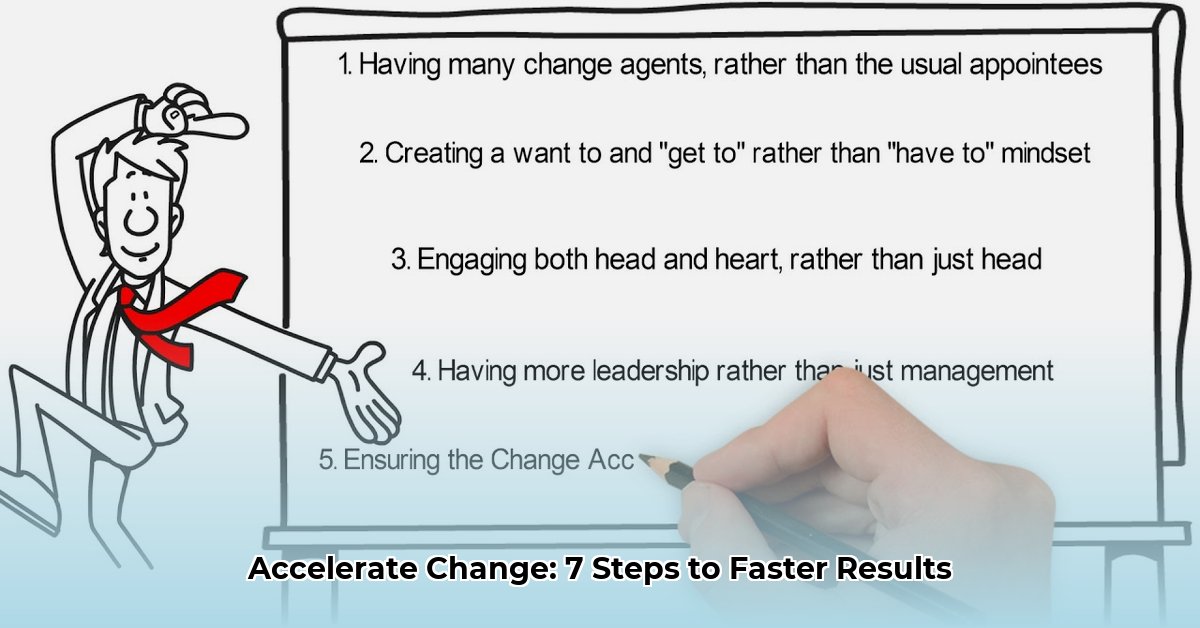Big changes at work can be unsettling. This guide provides a roadmap to navigate those changes smoothly and efficiently. We’ll break down the Change Acceleration Process (CAP) – a straightforward, seven-step plan – so you can confidently manage even the most complex transitions. We’ll cover crucial aspects, from fostering team alignment to anticipating potential challenges before they escalate. By the end, you’ll be equipped to lead your team through change and position your business for sustained success. Let’s begin!
Understanding the Change Acceleration Process
What exactly is the Change Acceleration Process (CAP)? It’s essentially a strategic framework for implementing significant organizational changes swiftly and effectively. Think of it as a catalyst, propelling your organization from its current state to its desired future state with minimal disruption. It’s not just about implementing change; it’s about ensuring widespread acceptance, fostering a positive attitude towards the change, and empowering everyone to contribute to its success. What are the fundamental principles of organizational change?
The Core Equation: Balancing Quality and Acceptance
At its heart, CAP is guided by a simple yet powerful equation: Success = Quality x Acceptance. Even the most technically sound solution will fall short if it lacks buy-in from the individuals who will be using it. CAP helps to ensure both – a robust solution and widespread enthusiasm for its adoption. It emphasizes the critical importance of building consensus and securing commitment. Change management experts emphasize that acceptance is paramount to project success.
Navigating Change: The 7-Step CAP Framework
CAP follows a structured seven-step process. Each step enhances the previous one, building momentum and maintaining forward progress. Let’s examine the process in detail: What are the key attributes of effective change leadership?
1. Leading with Purpose: This step requires leaders to be actively involved, setting the direction and ensuring that the team has access to the necessary resources. It involves demonstrating visible support, passionately advocating for the change, and conveying that this initiative is a top priority.
2. Establishing a Shared Understanding: Clearly articulate the rationale behind the change, highlighting the existing challenges and presenting a compelling vision of the improved future state. The goal is to cultivate a shared understanding and agreement on the need for change, rather than simply imposing it. Focus on engaging storytelling and impactful data.
3. Defining a Compelling Vision: Create a clear, concise, and inspiring vision of the future that demonstrates the tangible benefits of the change. Aim for clarity, relatability, and excitement. Develop a concise, memorable statement that embodies the transformed state.
4. Securing Widespread Commitment: This involves actively engaging everyone affected by the change. Solicit and address concerns, promote teamwork, and empower individuals to take ownership of the process. Foster a sense of value and ensure that every voice is heard. Implement open forums, team workshops, and feedback sessions.
5. Embedding Change for the Long Term: Successful changes become ingrained in the organization’s culture, systems, and processes. Integrate the changes into day-to-day operations, ensuring that they become an enduring part of the organization’s fabric. Implement training initiatives, integrate new tools with existing ones, and provide ongoing support.
6. Monitoring Progress and Adapting Swiftly: Monitor key metrics, celebrate achievements, and proactively adjust strategies as needed. Consistent feedback and data analysis are crucial. Emphasize learning and adaptation, not just achieving targets. Conduct regular check-ins and make timely adjustments based on performance data.
7. Aligning Systems and Structures: Ensure that organizational structures, systems, and processes support the changes. Failing to align these elements can undermine the entire initiative. Focus on process re-engineering, personnel adjustments, and organizational restructuring. What is the role of organizational structure in effective change initiatives?
Collaborating Effectively: Stakeholder Management
Successful CAP implementation depends on a clear understanding of all stakeholders and strategies for effective engagement. What are some effective strategies for improving stakeholder engagement?
| Stakeholder Group | Key Actions |
|---|---|
| Leadership Team | Provide unwavering support; allocate necessary resources; champion the vision |
| Change Management Team | Develop a thorough plan; monitor progress; address resistance; facilitate communication |
| Employees | Keep them informed; address concerns; provide training; solicit feedback |
| External Stakeholders | Maintain transparency; manage expectations; communicate updates effectively |
Mitigating Risks: Proactive Planning
Implementing CAP inevitably involves risks. Addressing these proactively is essential for success. Research shows that proactive risk management significantly increases project success rates.
| Risk Category | Potential Problem | Ways to Minimize the Risk |
|---|---|---|
| Leadership Commitment | Leaders lose interest or support diminishes | Secure ongoing support from leadership; maintain open communication channels; regularly update leaders on progress |
| Resistance to Change | Employees actively resist the new system | Proactively address concerns; build consensus; foster a sense of ownership; provide opportunities for input; highlight benefits |
| Communication Breakdown | Unclear messaging or failure to reach all stakeholders | Develop a comprehensive communication plan, using diverse channels; tailor messaging to specific audiences; establish feedback mechanisms |
| Resource Issues | Insufficient funding or lack of skilled personnel | Secure adequate funding; allocate resources strategically; invest in training and development; consider outsourcing |
| Sustainability Problems | Reversion to old habits after implementation | Develop reinforcement strategies; integrate new system into organizational culture; establish monitoring mechanisms; provide ongoing support and training |
Remember that CAP is not a one-size-fits-all methodology. Tailor it to your specific context. Through a focus on quality, acceptance, and forward-looking risk management, you’ll significantly improve your odds of successfully navigating change and fulfilling your objectives. What are the best practices for effective risk mitigation?
Measuring Long-Term Success of Change Acceleration Process Implementation
Key Takeaways:
- Successfully implementing CAP hinges on a carefully planned approach that integrates technical solutions with stakeholder engagement and sustainable adoption strategies.
- Measuring long-term success necessitates a clear understanding of initial goals and the development of relevant Key Performance Indicators (KPIs), along with continuous monitoring and flexibility.
- Long-term success is intrinsically linked to embedding CAP principles within the organization’s culture and processes, thereby cultivating a mindset of continuous improvement.
- Regularly evaluate and refine CAP methodologies based on data analysis to ensure lasting effectiveness.
- Implement robust risk mitigation strategies, including proactive stakeholder engagement and transparent communication, as vital components of long-term success.
Tracking Progress Over Time: Sustained Impact
You’ve successfully put a Change Acceleration Process (CAP) into action. Now, how do you determine if it truly made a difference? Simply completing the steps isn’t enough. Assessing the long-term success requires shifting your focus from short-term results to lasting and meaningful transformation. It’s about fostering a more resilient, adaptive, and agile organization. What specific metrics should be tracked throughout the change implementation?
Defining Success Metrics: Establishing a Baseline
Before you begin, clearly define your success criteria. What specific goals did you hope to achieve with CAP? Was it to improve efficiency, boost morale, or increase profitability? Convert these broad aspirations into specific, measurable, achievable, relevant, and time-bound (SMART) objectives. These objectives will serve as the foundation for your long-term evaluation. Metrics to consider include: What are the most important key performance indicators (KPIs) for measuring organizational change?
- Efficiency Improvements: Quantify gains in process efficiency, resource allocation, and cost reduction.
- Productivity Gains: Measure increases in output per employee or team, reflecting improved workflows.
- Employee Engagement: Track satisfaction scores, retention rates, and feedback related to the implemented changes.
- Customer Satisfaction: Evaluate the impact of the changes on customer experience and loyalty metrics.
- Financial Performance: Monitor key financial indicators such as revenue growth, profitability margins, and return on investment (ROI).
Beyond Quantitative Data: Qualitative Insights
While quantitative data is essential, don’t neglect the qualitative dimensions. Conduct periodic check-ins and surveys to assess employee perceptions of the change. Use focus groups, interviews, and observational studies to gain deeper insights into the enduring impact of the CAP implementation. Are employees fully embracing the new processes? Have organizational behaviors genuinely shifted? Which qualitative methods are best for assessing the impact of change initiatives?
Maintaining Momentum: Continuous Adaptation
Assessing long-term success isn’t a one-time activity; it demands ongoing monitoring and adaptive management. Regularly review your KPIs, assess progress against your initial targets, and make timely adjustments based on your findings. Flexibility is paramount. Modifying the CAP based on these insights is essential for maximizing its sustained impact. What are the best practices for continuously monitoring change projects?
Embedding CAP into Organizational Culture
To create a lasting impact, integrate CAP principles into the fabric of your organization. This involves a fundamental change in mindset and approach, not just a temporary project. Establish clear processes for managing future changes and providing ongoing training and support to employees. How can CAP be integrated into everyday operations? Emphasize leadership buy-in, transparent communication, and robust feedback loops.
- Water Mill Electricity Generator Provides Free Home Power - December 16, 2025
- Water Wheel Electric Generator Provides Free Home Electricity - December 15, 2025
- Choosing the Right Portable Hydro Turbine for Your Needs - December 14, 2025
















